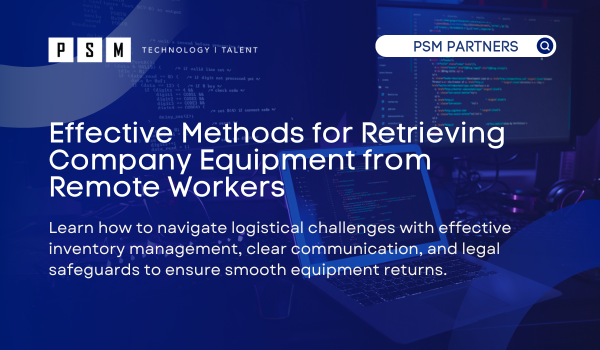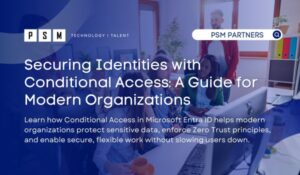Table of Contents
ToggleHow do you reclaim company equipment from remote workers efficiently? This article covers effective methods to tackle logistical challenges, including inventory management, clear communication, and legal safeguards to ensure smooth equipment returns.
Key Takeaways
Establishing a Remote Employee Equipment Agreement and clear inventory procedures are crucial for ensuring the return of company assets from remote workers.
Effective offboarding processes, including detailed instructions and timely follow-ups, are essential to reclaiming company equipment and minimizing legal risks and financial losses.
Leveraging technology and professional services, such as Asset Lifecycle Management and Mobile Device Management solutions, enhances organizational efficiency and security in handling IT assets.
In an era where the boundaries between office and home blur, the phenomenon of remote work has cemented its place in the corporate landscape. A staggering 91%of workers now show a preference for jobs that offer some form of remote work option. This shift has left businesses grappling with a new challenge: retrieving company equipment from remote workers. The stakes are high; failure to efficiently reclaim tools of the trade can lead to unwelcome data breaches and significant financial losses.
HR professionals often handle the retrieval process, coordinating the return of items like laptops and smartphones. This process is a logistical dance, demanding precision and foresight. Establishing a detailed inventory and clear packing instructions is the linchpin in ensuring the safe return of company assets in pristine condition. Additionally, a Remote Employee Equipment Agreement underlines the seriousness of the matter, indicating to employees that returning company property isn’t optional—it’s a contractual duty.
Documentation is the silent guardian in this process. Signed acknowledgments act as proof of the employee’s understanding of their responsibility to return company equipment. This understanding is critical to preventing complications down the road. Given the rise in remote work, creating a company policy regarding equipment return is not a mere suggestion—it’s a necessity. Also, clear communication and efficient logistics play a crucial role, acting as the lifeblood of successful equipment returns.
Setting clear expectations from the start, perhaps during onboarding, lays a stable foundation for the eventual retrieval of company property and handling refund situations. Designating a responsible individual or team to oversee the return process ensures that accountability is maintained throughout. Leveraging technology, such as tracking tools, can help save costs and streamline the process, keeping it as painless as possible for all involved parties. A transparent and accessible return policy is the best defense against potential disputes and unexpected charges.
How to Initiate the Equipment Retrieval Processes

Before initiating the retrieval process, HR or IT departments need to take into account the entire lifecycle of IT assets related to departing employees. This comprehensive understanding offers greater control over technology routing, inventory management, and cost containment.
To navigate the waters of equipment return, there are several strategies that companies can employ to avoid unreturned equipment charges:
Develop a Remote Work Equipment Policy: A robust policy will be your guiding star, outlining the expectations and responsibilities for remote workers when it comes to company equipment. It lays the groundwork for a standardized approach to equipment management and sets the tone for the entire retrieval process.
Initiate the Offboarding Process: Offboarding is more than a farewell handshake; it’s a systematic approach to reclaiming company assets. Start with a face-to-face meeting, if possible, to encourage cooperation and underscore the importance of returning company equipment. Follow up with a comprehensive letter or email, complete with a prepaid shipping label and detailed pickup instructions. If the response is lacking, send reminders that highlight the gravity of the situation and the potential for legal consequences if the items are not returned. After an ample waiting period, a final notice may be necessary, outlining the intent to pursue legal action if necessary.
What Condition Is the Equipment In: Once equipment is returned, assess its condition promptly. A thorough inspection within 24 hours of receipt is critical for identifying any damage and resolving issues swiftly. Effective communication with the employee, backed by written documentation and photographic evidence, ensures a transparent and accountable process.
Where Does the Equipment Get Stored: Proper storage and inventory management are vital. A secure IT storage solution, paired with a centralized inventory system, should be in place. This not only protects valuable equipment but also streamlines the retrieval and distribution process, enhancing overall organizational efficiency. Implementing a Mobile Device Management (MDM) solution like Microsoft Intune further optimizes these processes, ensuring technical control and security compliance over all company-issued devices.
Best Practices for Equipment Returns

Ensuring the secure and timely return of company equipment from departing remote workers is a multifaceted process that involves coordination across various departments. Here are some best practices to consider:
Packaging: Make sure that the former employee has the right materials, such as a sturdy cardboard box and protective padding, to ensure the equipment is well-protected during transit. The packaging should be robust enough to withstand the journey back to the company without incurring damage. Consider visiting a UPS Store for appropriate packaging supplies.
Pickup or drop-off: The convenience of returning company equipment can greatly influence the speed and success of the process. If feasible, offering a home pickup service can remove barriers and ensure the equipment is collected in a timely manner. To further streamline the process, make sure to provide a clear return address for those who prefer the drop-off option. It’s important to note that both options should be communicated effectively to employees.
Paragraph 3: Return Shipping Label: Providing a straightforward, easy-to-follow process for the employee to access a return label is essential. Whether you send the label directly or provide instructions for printing one, make sure the process is hassle-free to expedite the return.
Instructions: Clarity is key when communicating with the departing employee about the return process. Provide explicit instructions regarding which items need to be returned and whether any originally provided items, like cables or accessories, can be kept by the employee or if they need to cancel any ongoing services associated with the items.
What Happens if an Employee Doesn't Return Company Equipment?
When a former employee fails to respond regarding the return of company property, it calls for a careful balancing act. On one hand, the company must protect its assets; on the other, it’s important to maintain a positive work environment.
When equipment remains unreturned, the implications are twofold: financial strain on the company and potential legal entanglements. The initial steps are sending out reminders, but if these prove ineffective, it’s time to weigh the value of the equipment against the likelihood and cost of recovery through legal means. Such decisions must be made with the company’s culture and employee morale in mind. Open communication about the process can help maintain transparency and a professional atmosphere.
Effective offboarding is about more than just collecting equipment; it’s about preserving the integrity of the company and its culture. Implementing clear protocols, seeking legal guidance where necessary, and maintaining open lines of communication can help businesses navigate these challenges in a professional manner.
Streamline Your IT Equipment Needs with PSM Partners
It can be challenging to navigate the complexities of IT equipment management in a remote work setting. PSM Partners rises to the occasion, offering tailored solutions to streamline the entire lifecycle of your IT assets.
With a suite of services, including Asset Lifecycle Management and IT Cost Analysis & Management, PSM Partners acts as an extension of your business, shouldering the burden of IT infrastructure management. Our proactive monitoring and expert management of your IT needs boost efficiency and cost-effectiveness, allowing you to concentrate on your main business activities.
To discover how PSM Partners can transform your IT operations and provide peace of mind, contact us today. Our team of experts is ready to tailor a solution that fits your unique needs and challenges, ensuring your business is well-equipped to succeed in today’s digital landscape.
Frequently Asked Questions
What should be included in a Remote Work Equipment Policy?
A Remote Work Equipment Policy should include responsibilities for company-issued equipment, the process for reporting damaged items, and expectations for maintaining and storing the equipment. It should also cover the conditions for returning items upon termination of employment, to ensure clarity and compliance among remote employees.
How can I ensure the safe return of company equipment?
To ensure the safe return of company equipment, it is essential to provide appropriate packaging and return shipping labels, offer convenient pickup or drop-off options, and give clear instructions. Having employees sign an acknowledgment upon receiving the equipment can also facilitate a smooth return process.
What actions can a company take if an employee does not return company equipment?
The company should follow its offboarding protocol, which may involve reminders and outlining consequences. Legal action may be considered based on the value of the equipment and the likelihood of recovery.
How does PSM Partners help with managing IT equipment?
PSM Partners offers Asset Lifecycle Management and IT Cost Analysis & Management services, which aid businesses in effectively managing their IT infrastructure by monitoring, managing, and optimizing the use of IT assets throughout their lifecycle.
Is it necessary to inspect returned equipment immediately?
Yes, it is necessary to inspect returned equipment immediately to identify damage or maintenance needs and minimize operational disruptions.
Related Insights
IT Consulting vs Tech Consulting: What’s the Difference?
Key Takeaways What’s the difference between IT consulting and tech...
Read MoreWhat Is Spillage in Cybersecurity — And How Can Your Business Prevent It?
Frequently Asked Questions (FAQ) About Spillage What is spillage in...
Read MoreSecuring Identities with Conditional Access: A Guide for Modern Organizations
Key Takeaways What is Conditional Access? Conditional Access (CA) is...
Read MoreMaximizing Efficiency with Managed Services Telecom Solutions
Key Takeaways What Is a Telecom Managed Services Provider? A...
Read MoreAbout the Author

Taylor Friend
I'm a goal-oriented Strategic Alliance Manager who is enthusiastic about building and nurturing collaborative relationships that drive business success. My commitment lies in establishing, overseeing, and expanding partnerships that generate greater business opportunities and foster revenue growth for all stakeholders.





